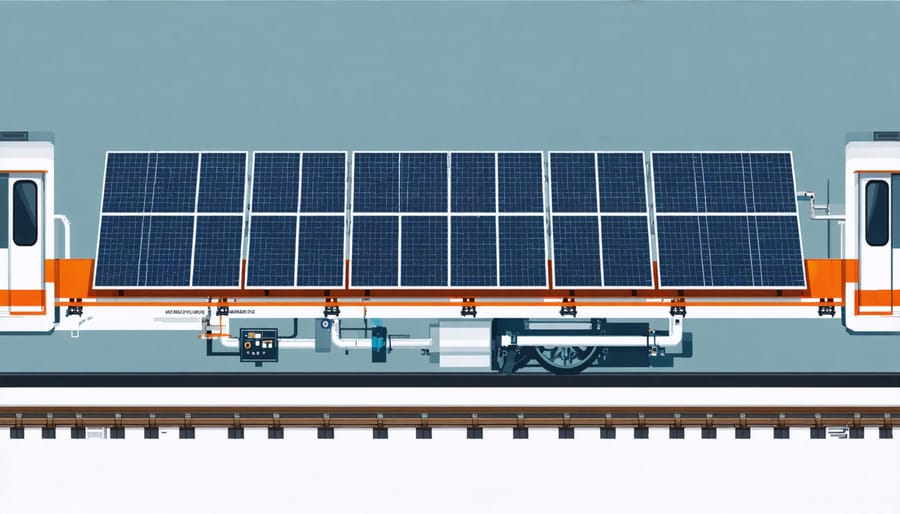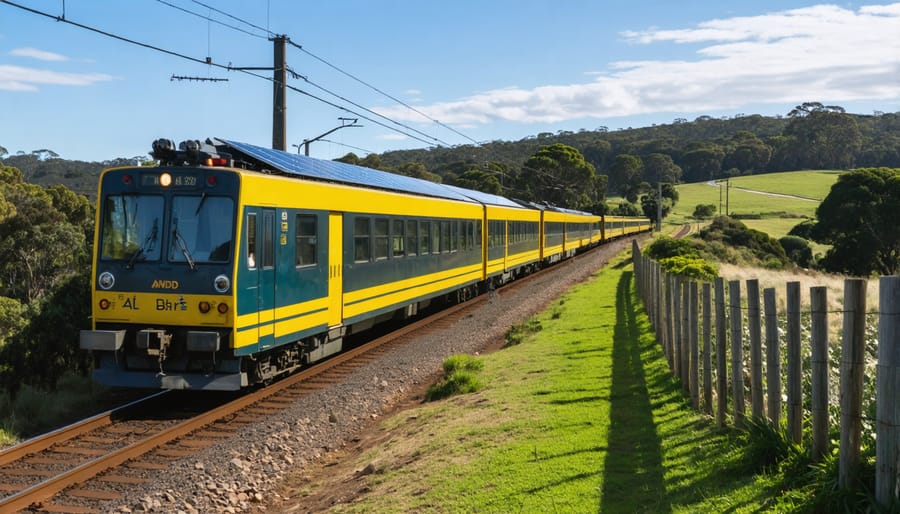Solar-Powered Trains Are Revolutionizing Green Transportation (Here’s How)
Revolutionizing rail transport with sunlight, solar-powered trains represent one of the most promising clean transportation solutions emerging in the 21st century. By harnessing solar energy through photovoltaic panels installed along railway tracks and train rooftops, these innovative systems are transforming how we think about sustainable mass transit. Already operational in several countries, including India’s solar-powered commuter trains and Byron Bay’s Solar Train in Australia, this technology demonstrates how renewable energy can power even the most demanding transportation needs. The integration of solar power into railway systems not only slashes carbon emissions but also significantly reduces operational costs, with some networks reporting up to 70% energy savings compared to conventional diesel-electric trains. As cities worldwide seek sustainable alternatives to traditional rail transport, solar-powered trains offer a compelling blueprint for the future of clean, efficient, and economically viable public transportation.
How Solar-Powered Trains Actually Work
Solar Panel Integration Systems
Modern solar panel integration systems in trains combine innovative design with practical functionality. These systems typically feature three main components: roof-mounted panels, track-side solar arrays, and energy storage units.
Roof-mounted panels are specially designed to be lightweight and aerodynamic, covering the train’s top surface without significantly impacting its performance. These panels use flexible photovoltaic materials that can withstand vibrations and varying weather conditions while generating power during daylight hours.
Track-side integration involves installing solar panels along railway corridors, particularly in open areas with maximum sun exposure. These panels connect to power distribution systems that feed directly into the train’s electrical network. Some designs incorporate solar panels into noise barriers and platform shelters, maximizing available space while serving multiple purposes.
The energy collection system works through sophisticated power management controllers that regulate the flow of solar-generated electricity. During peak sunlight hours, excess energy is stored in advanced battery systems for use during cloudy periods or nighttime operation. This ensures a consistent power supply and reduces dependence on traditional power sources.
Most modern installations use smart monitoring systems that track energy production and consumption in real-time, allowing operators to optimize power usage and maintain system efficiency. This integrated approach helps railway operators achieve a balance between renewable energy utilization and operational reliability.

Energy Storage Solutions
Energy storage is the backbone of solar-powered train systems, ensuring consistent operation even when direct sunlight isn’t available. Modern trains employ advanced battery systems that can store massive amounts of solar energy collected during peak sunlight hours. These batteries act like giant power banks, similar to the ones we use for our phones, but on a much larger scale.
The most common storage solution uses lithium-ion battery banks, which are strategically placed along the train’s length. These batteries are specially designed to handle the high-power demands of train acceleration while maintaining efficiency during regular operation. Some systems also incorporate regenerative braking, which captures and stores energy that would otherwise be lost when the train slows down.
Power management systems play a crucial role in optimizing energy use. Smart controllers monitor energy levels, weather conditions, and train schedules to ensure power is distributed effectively. During sunny days, excess energy is stored for use during nights or cloudy weather. This intelligent system can also prioritize power distribution based on immediate needs, such as acceleration or maintaining cabin temperature.
Backup systems are always in place to ensure safety and reliability. Most solar-powered trains maintain a connection to the traditional power grid or have diesel generators as emergency backup, though these are rarely needed in well-designed systems.
Real-World Success Stories
Byron Bay Solar Train
The Byron Bay Solar Train stands as a shining example of sustainable transportation done right. Launched in December 2017, this pioneering project converted a heritage 1949 diesel train into the world’s first fully solar-powered train service. Operating on a 3-kilometer coastal route between Byron Bay’s town center and the North Beach precinct, this innovative service carries up to 100 passengers per trip.
What makes this train truly remarkable is its elegant power solution. The train’s roof houses custom-curved solar panels that generate much of its operational energy. Additional solar panels installed on the storage shed roof provide supplementary power, ensuring the train can run reliably throughout the day. The system includes a sophisticated battery storage solution that keeps the train running even during cloudy weather.
The train’s success has exceeded expectations, with over 100,000 passengers riding annually. It saves approximately 30,000 liters of diesel fuel each year and produces zero emissions during operation. Most impressively, the train can complete a round trip on a single charge, with regenerative braking helping to conserve energy.
Local resident Sarah Thompson, a regular commuter, shares, “It’s not just environmentally friendly – it’s a joy to ride. The quiet, smooth journey along the coast is something special, and knowing we’re not contributing to pollution makes it even better.”
The Byron Bay Solar Train has become both a practical transport solution and a tourist attraction, proving that sustainable transportation can be commercially viable while preserving historical charm. Its success has inspired similar projects worldwide and demonstrates how solar power can revolutionize public transportation.

Indian Railways Solar Initiative
Indian Railways has emerged as a global leader in sustainable transportation with its ambitious solar initiatives. Since 2017, the national railway system has been progressively incorporating solar power into its operations, making significant strides toward reducing its carbon footprint while saving millions in energy costs.
The most notable achievement is the Delhi Metro Rail, which became the world’s first railway network to run entirely on solar power. The system draws energy from the Rewa Ultra Mega Solar project in Madhya Pradesh, demonstrating how large-scale solar adoption can transform public transportation.
In 2019, Indian Railways launched its first experimental solar-powered train, featuring solar panels mounted directly on passenger coach rooftops. These panels power the internal lighting, fans, and information displays, reducing diesel consumption by up to 90,000 liters per year per train. The success of this pilot project led to the expansion of solar panel installations across multiple train routes.
The railway system has also implemented innovative solar solutions at stations and manufacturing facilities. Over 960 railway stations now operate on solar power, with installations ranging from rooftop panels to ground-mounted systems. These installations collectively generate more than 1,000 megawatts of clean energy annually.
Looking ahead, Indian Railways aims to achieve complete electrification and net-zero emissions by 2030. The organization plans to install solar panels on 51,000 hectares of vacant railway land and expand its current solar capacity to 20 gigawatts. This commitment serves as an inspiring model for railway systems worldwide, proving that large-scale solar adoption in transportation is both feasible and economically viable.
Environmental and Economic Benefits
Carbon Footprint Reduction
Solar-powered trains represent a significant leap forward in reducing the transportation sector’s carbon footprint. Traditional diesel-powered trains emit approximately 915 grams of CO2 per passenger mile, while solar-powered trains can potentially reduce these emissions to near zero during operation.
Studies show that a single solar-powered train line can eliminate up to 20,000 tons of carbon dioxide emissions annually – equivalent to removing 4,000 cars from the road. In places like India, where the Delhi Metro Rail Corporation has implemented solar power, they’ve achieved a 30% reduction in their carbon footprint within the first year of operation.
The environmental benefits extend beyond just carbon reduction. Solar-powered trains help improve local air quality by eliminating diesel particulate matter and nitrogen oxides. They also reduce noise pollution, as electric motors operate more quietly than diesel engines.
When considering the full lifecycle impact, solar-powered trains become even more impressive. The solar panels used to power these trains typically have a lifespan of 25-30 years, during which they generate clean energy with minimal maintenance requirements. Even accounting for the environmental cost of manufacturing solar panels, the net carbon reduction over their lifetime is substantial.
By combining solar power with energy storage systems, these trains can maintain their environmental benefits even during cloudy days or nighttime operation, ensuring consistent carbon reduction throughout their service life.

Cost Savings Over Time
The financial benefits of solar-powered trains become increasingly evident when analyzing long-term operational costs. Rail operators can significantly reduce energy costs through solar implementation, with many systems achieving ROI within 5-7 years of installation.
Studies show that a medium-sized railway station equipped with solar panels can save approximately $50,000 annually in electricity costs. These savings compound over time, as solar installations typically last 25-30 years with minimal maintenance requirements. When factoring in rising traditional energy costs, the financial advantages become even more pronounced.
For example, Indian Railways reported a 60% reduction in their energy bills after implementing solar power across several stations and tracks. This translates to millions in savings annually, while simultaneously decreasing their carbon footprint. The initial investment, while substantial, is offset by government incentives, tax benefits, and reduced operational expenses.
Maintenance costs also tend to be lower compared to traditional electrical systems, as solar components have fewer moving parts and require less frequent replacement. Additionally, excess energy generated during peak sunlight hours can be stored or sold back to the grid, creating additional revenue streams for railway operators.
Future of Solar Trains
The future of solar-powered trains holds tremendous promise as technology continues to advance and innovation drives new possibilities. As industrial solar applications become more sophisticated, we’re seeing exciting developments that could revolutionize rail transport.
One of the most promising advances is the development of more efficient photovoltaic panels specifically designed for moving vehicles. These next-generation solar panels are lighter, more flexible, and capable of capturing energy even in less-than-ideal weather conditions. Engineers are also working on improved energy storage systems that can hold more power in smaller, lighter batteries, making solar trains more practical for longer routes.
Smart energy management systems are another game-changing innovation on the horizon. These systems will use artificial intelligence to optimize power consumption, automatically adjusting energy use based on factors like weather conditions, passenger load, and route characteristics. This means trains will be able to operate more efficiently while maximizing their solar power usage.
We’re also seeing exciting developments in solar track technology. Researchers are exploring ways to integrate solar panels directly into railway infrastructure, creating “solar corridors” that can power trains as they pass through. This could effectively turn entire railway networks into massive solar power plants.
The integration of wireless charging technology is another breakthrough that could transform solar train operations. This would allow trains to receive power from solar installations along their route without the need for direct contact, making the system more reliable and maintenance-friendly.
Looking ahead, we can expect to see hybrid systems that combine solar power with other renewable energy sources, creating more resilient and reliable transportation networks. These developments, coupled with decreasing solar technology costs and improving efficiency, suggest that solar-powered trains will become increasingly common in our transportation landscape.
As cities worldwide commit to reducing their carbon footprint, these innovations in solar train technology offer a clear path toward sustainable mass transit solutions that are both environmentally friendly and economically viable.
As we look to a more sustainable future in transportation, solar-powered trains represent a groundbreaking solution that combines innovation with environmental responsibility. These revolutionary vehicles are already proving their worth across various pilot projects worldwide, demonstrating that clean, renewable energy can power even our largest transit systems.
The impact of solar-powered trains extends far beyond reducing carbon emissions. They offer significant cost savings for railway operators, create new jobs in the renewable energy sector, and provide more reliable service with less dependence on traditional power grids. Communities along railway routes benefit from reduced noise pollution and improved air quality, while passengers enjoy knowing their journey contributes to environmental conservation.
Looking ahead, the potential for solar-powered trains appears boundless. As solar technology continues to advance and become more efficient, we can expect to see more railway networks embracing this sustainable solution. The integration of smart grid systems and energy storage solutions will further enhance the reliability and effectiveness of solar-powered trains.
For property owners and businesses near railway lines, this transformation presents unique opportunities to participate in the renewable energy revolution. Whether through solar panel installations along tracks or partnerships with railway operators, stakeholders can contribute to and benefit from this sustainable transportation solution.
The journey toward fully solar-powered railway systems may be gradual, but the destination is clear: a cleaner, more sustainable future for rail transport that benefits both people and planet.











